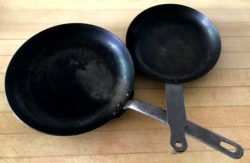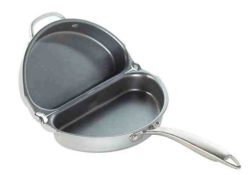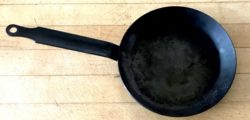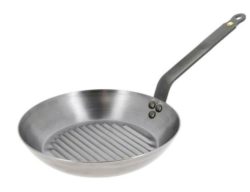Read Time: 7 Minutes Subscribe & Share
A Loophole Benefits A Shop
 In the 1970s, my tiny shop in Old Town was in a unique position to import directly from small companies in Europe and Asia. Quaint Alexandria had its own customs house because, as a neighborhood, we housed the firearms arsenal for Interarmco. The sordid saga of Interarmco and its owner makes for fascinating reading. And of course for years, no one really knew that it would take very little to blow Old Town to smithereens if a fire had occurred. This bizzare arrangement to suit post- WWII munitions overload was housed in a defunct Ford factory near several undistinguished warehouses, now the site of a waterfront residential community under the name of Ford’s Landing. The US Customs Office itself was situated in an undamaged part of the plant, which had been designed by Albert Kahn in the 1930s. I remember being struck by all the beautiful Art Deco interior effects when I would go to have shipments be cleared. The Customs Officer volunteered that I could not only bring in what I wanted, and that it would be cleared hassle-free, but that my building could be bonded as a US Customs Warehouse so that any international shipment would be delivered inside my door and a Customs officer would come and sign off. This loophole that the federal government had arranged for Interarmco opened up a whole world to me — none of it involving weaponry more lethal than chef’s knives. The shop and clients benefited from having really good quality European kitchen equipment with a better price than what was normally charged. This ended when customs procedures were internationalized and reorganized with the advance of internet technology. But one of the suppliers was a small company in the Vosges mountains of France named De Buyer.
In the 1970s, my tiny shop in Old Town was in a unique position to import directly from small companies in Europe and Asia. Quaint Alexandria had its own customs house because, as a neighborhood, we housed the firearms arsenal for Interarmco. The sordid saga of Interarmco and its owner makes for fascinating reading. And of course for years, no one really knew that it would take very little to blow Old Town to smithereens if a fire had occurred. This bizzare arrangement to suit post- WWII munitions overload was housed in a defunct Ford factory near several undistinguished warehouses, now the site of a waterfront residential community under the name of Ford’s Landing. The US Customs Office itself was situated in an undamaged part of the plant, which had been designed by Albert Kahn in the 1930s. I remember being struck by all the beautiful Art Deco interior effects when I would go to have shipments be cleared. The Customs Officer volunteered that I could not only bring in what I wanted, and that it would be cleared hassle-free, but that my building could be bonded as a US Customs Warehouse so that any international shipment would be delivered inside my door and a Customs officer would come and sign off. This loophole that the federal government had arranged for Interarmco opened up a whole world to me — none of it involving weaponry more lethal than chef’s knives. The shop and clients benefited from having really good quality European kitchen equipment with a better price than what was normally charged. This ended when customs procedures were internationalized and reorganized with the advance of internet technology. But one of the suppliers was a small company in the Vosges mountains of France named De Buyer.
Cookware To Inherit
 The pan pictured to the right, which I have had almost from the inception of La Cuisine in the early 1970s, has been one of the few contested objects of desire when I go to The Great Kitchen In The Sky. One of my daughters and my long-time manager have both wistfully laid in a request. This pan has fried bacon, seared steaks and roasts, made grilled cheese sandwiches two at a time, and so many other cooking chores, it would take too long to list. It is so unbelievably non-stick, it would make the chemistry wizards at cookware companies weep. It performed so well and survived my signature abuse of all things kitchenware, that I bought more pieces as needed. I now have the omelet pan in two sizes, two crepe pans and several of the round fry pans, a grill pan and a combo casserole fry pan.
The pan pictured to the right, which I have had almost from the inception of La Cuisine in the early 1970s, has been one of the few contested objects of desire when I go to The Great Kitchen In The Sky. One of my daughters and my long-time manager have both wistfully laid in a request. This pan has fried bacon, seared steaks and roasts, made grilled cheese sandwiches two at a time, and so many other cooking chores, it would take too long to list. It is so unbelievably non-stick, it would make the chemistry wizards at cookware companies weep. It performed so well and survived my signature abuse of all things kitchenware, that I bought more pieces as needed. I now have the omelet pan in two sizes, two crepe pans and several of the round fry pans, a grill pan and a combo casserole fry pan.
So who is the producer of this “miracle” cookware? De Buyer in La Val d’Ajol, France, was founded as a small forge in 1830 by the De Buyer family. It fabricated cooking utensils that could be used to cook over direct flame and also hold water for cooking and dining purposes, at a time when there was no electricity or gas for any home or restaurant. De Buyer has evolved over the centuries into a company that produces first-rate professional cookware and utensils. I discovered them at a restaurant trade show in Paris. But let’s talk about the unique qualities of their carbon steel cookware.
Combining Carbon With Iron
Carbon Steel is iron mixed with carbon, which allows the fabricator to roll it out in sheets and create pliable shapes. Cast iron is molten iron poured or cast into a mold and then hardened and polished after it is released from the mold. Traditionally, cast iron pieces have short handles that are integral to the mold. Carbon steel can be stamped in a variety of shapes, with longer handles welded or riveted to the shape. The longer De Buyer handles are angled so that it is easier on your wrist than a short cast iron handle when you have to manipulate the pan on the burner. It is quicker to heat up and cool down than cast iron. Unlike stainless steel, it gives you an even sear and slow, even cooking across its surface. You can “season” carbon steel or cast iron by allowing fat to burn onto the pan, thus creating with a bit a patience a pretty good non-stick surface that you can renew when needed. De Buyer makes a couple of different gauges of carbon steel, and I prefer the heavier ones, but you have options when you go through the products section of their website. The “Mineral B” process you see on some of their pieces is a protective beeswax finish that helps protect the pan from rust (and in a natural way without adding harmful chemicals to you and the planet). Below are a couple of examples of traditional designs, which have not been “improved” upon by aimless 20th century fiddling.
What Is An Omelet Pan
 Pictured on the left is a real omelet pan by De Buyer. The left one has a forged handle and the one to the right has a stamped flat handle. Pictured on the right is a ridiculous contraption guaranteed
Pictured on the left is a real omelet pan by De Buyer. The left one has a forged handle and the one to the right has a stamped flat handle. Pictured on the right is a ridiculous contraption guaranteed  to feed your anxiety and destroy all hope of ever achieving an omelet. The curved slope on the De Buyer pan makes it really easy to quickly slide the omelet mixture around over high heat, sprinkle in your filling, use the curve to turn or flip the omelet over the filling, and roll it out onto a plate. This is done in less time than it takes to read the care instructions on the hinged pan on the right. I have also used the De Buyer pan to make frittatas and Basque-style omelets. Again, the curved sides, along with the slick seasoned surface give you beautiful results as you can easily slide the omelet or fritatta out of the pan.
to feed your anxiety and destroy all hope of ever achieving an omelet. The curved slope on the De Buyer pan makes it really easy to quickly slide the omelet mixture around over high heat, sprinkle in your filling, use the curve to turn or flip the omelet over the filling, and roll it out onto a plate. This is done in less time than it takes to read the care instructions on the hinged pan on the right. I have also used the De Buyer pan to make frittatas and Basque-style omelets. Again, the curved sides, along with the slick seasoned surface give you beautiful results as you can easily slide the omelet or fritatta out of the pan.
A Real Crèpe Pan
 One of the benefits of carbon steel, along with its easy reception to “seasoning,” is how quickly you can get a lacy, caramelized sear, and a proper crèpe pan gives you the perfect example. If you
One of the benefits of carbon steel, along with its easy reception to “seasoning,” is how quickly you can get a lacy, caramelized sear, and a proper crèpe pan gives you the perfect example. If you  look at the design of a De Buyer crepe pan, you see the short, wide-angled side of the pan, which defines the circumference of the crepe. You throw a bit of butter in to the heated pan (I use a high heat to a medium high heat) and listen to it start and cease bubbling. You ladle in enough batter to lightly film the pan, which you are swirling as you pour the batter in. In seconds, one side achieves a lacy caramelized pattern, You flip it with whatever offset spatula you like, which is easily done due to the short height and wide angle of the pan’s side – and finish off the other side for another few seconds. And boom, you are done. When you are finished, you wipe down the pan and hang it up. One of my issues with all non-stick surfaces is that they make it so difficult to get a really lovely cooked finish on your crèpe or omelet. By design, any chemical non-stick interior makes food pull away from that surface. Many times, you get sort of a sweaty and pale finish on the food you are cooking. And the contraption on the right shows you how complicated one can make the process of producing a peaked, flaccid crèpe.
look at the design of a De Buyer crepe pan, you see the short, wide-angled side of the pan, which defines the circumference of the crepe. You throw a bit of butter in to the heated pan (I use a high heat to a medium high heat) and listen to it start and cease bubbling. You ladle in enough batter to lightly film the pan, which you are swirling as you pour the batter in. In seconds, one side achieves a lacy caramelized pattern, You flip it with whatever offset spatula you like, which is easily done due to the short height and wide angle of the pan’s side – and finish off the other side for another few seconds. And boom, you are done. When you are finished, you wipe down the pan and hang it up. One of my issues with all non-stick surfaces is that they make it so difficult to get a really lovely cooked finish on your crèpe or omelet. By design, any chemical non-stick interior makes food pull away from that surface. Many times, you get sort of a sweaty and pale finish on the food you are cooking. And the contraption on the right shows you how complicated one can make the process of producing a peaked, flaccid crèpe.
Cookware Not Housewares.
 When I wrote the Dark Waters post about chemical non-stick coatings and the poisoning of our kitchens,
When I wrote the Dark Waters post about chemical non-stick coatings and the poisoning of our kitchens,  waterways and bodies, I received quite a few emails asking for advice on good cookware. While there is no one vessel that “does it all” perfectly, there are manufacturers of good cookware that will last generations and not become part of a landfill. My mantra has been, if it is good enough for a serious restaurant kitchen, then it needs to be in mine. De Buyer’s carbon steel is one of them. They have inaugurated a new US based website and have offered a 20% discount to KD readers. I recently replaced a large crèpe pan (also handy for tortillas)that I had left at a beach vacation house and a casserole-type pan in which I seared a pot roast and then finished it off entirely on top of the stove. This will also be my pan to make frites (a future post involving adventures in numerous types of frying fats). We sold many in the shop, and I never was able to nab one. The third is their new design for a grill pan, which will be tried out shortly. Whatever you choose, follow the seasoning instructions and you, too, will have your heirs fighting over who gets one of your coveted De Buyer pans.
waterways and bodies, I received quite a few emails asking for advice on good cookware. While there is no one vessel that “does it all” perfectly, there are manufacturers of good cookware that will last generations and not become part of a landfill. My mantra has been, if it is good enough for a serious restaurant kitchen, then it needs to be in mine. De Buyer’s carbon steel is one of them. They have inaugurated a new US based website and have offered a 20% discount to KD readers. I recently replaced a large crèpe pan (also handy for tortillas)that I had left at a beach vacation house and a casserole-type pan in which I seared a pot roast and then finished it off entirely on top of the stove. This will also be my pan to make frites (a future post involving adventures in numerous types of frying fats). We sold many in the shop, and I never was able to nab one. The third is their new design for a grill pan, which will be tried out shortly. Whatever you choose, follow the seasoning instructions and you, too, will have your heirs fighting over who gets one of your coveted De Buyer pans.
KD readers have until June 13, 2020 to use the code KITCHENDETAIL20 for 20% OFF any purchase from the De Buyer website.

Kitchen Detail shares under the radar recipes, explores the art of cooking, the stories behind food, and the tools that bring it all together, while uncovering the social, political, and environmental truths that shape our culinary world.




De Buyer makes some of the best pastry and cooking products, so excited that they now have a US based website, this is going to be a very expensive Wednesday…
Diane,
De Buyer produces so many great tools, and I plan to share my thoughts on others too. I would love to hear from you which of their pastry tools you love.
Nancy
OMG, Nancy! Literally just yesterday I suddenly thought, with a huge pang, about my “French frying pan” that I lost in a divorce property settlement many years ago. It was a De Buyer I picked up while living in England in the 70s… I am a big carbon steel fan and still use the Sabatier knives I bought from you when I moved to Old Town in 1980. Yes, it could be an expensive Wednesday.
Gretchen, I don’t know whether to laugh or cry about the De Buyer carbon steel pan being lost in the divorce settlement! Let me know what you have decided to replace it with.
Nancy
Oh, happy day! Package from Amazon arrived yesterday with a 10″ grill pan and 8″ fry pan! BTW, I live in an ‘electric’ building but still use le Creuset on the hobs. I just can’t sklonk the pan on the surface to shake contents like I could with gas or old-fashioned electric burners. I have also successfully used my mother’s Edwardian copper fish poacher on the ceramic surface and it does NOT have a smooth bottom. It is 100 years old.
Nancy, we have a glass topped flat electric range and I am wondering about using carbon steel on electric. I know they don’t recommend cast iron. But I am in dire need of new pans. Thanks.
Hi Raymond, The reason that they do not recommend cast iron for an induction range is that normally the bottom of a cast iron pan has a ring that raises it from the surface of the magnetic field. I am not sure why they don’t recommend them for glass flat tops. My experience though with that type of range has been pretty miserable. Carbon steel is perfect because it is flat and obviously has a magnetic field.for induction. If your cast iron pan pan is perfectly flat, I don’t see why it should not work on an electric range.Let me… Read more »
So which model and size is the first one pictured, the one you say has done all the things? Could I use it for scrambled eggs? Crêpes? As well as for chicken thighs, burgers, fish?
Brooke,
The oval pan would be too big for scrambled eggs, but fine for burgers, definitely fish and it would fit 6 chicken thighs. I have used my omelet pan out of desperation to make crèpes, but it is easier with the pan shown and described. Currently they only show the oval pan with the “Choc” nonstick on their US website. You should write and ask them when they plan to make this one available in the US. https://www.debuyer.com/en/products/carbone-plus-fish-frying-pan
Nancy
I have a DeBuyer skillet that I bought at your store several years ago, and I need to buy a lid for it. Any recommendations?
Hi Elaine,
De Buyer sells their Prima Matera lids separately. I have also found that any lid that fits the centimeter measurement of another pan works on my De Buyer frypans.
Nancy
Nancy, you make me spend all my money! I have a kitchen full of Sertodo Copper, a tomato knife, little cleaning brushes, and now I’m getting a new omelet pan.
Susan,
I have a Sertado copper saute pan which I bought this year and I am quite happy with it. The handle design is really handy for my spatula. The tomato knife and the dish brush go in the travel bag, we both use them every day.
Nancy
Nancy this is a very nice discount on the DeBuyer cookware I just purchased and I am anxious to start putting them to heavy use as soon as they arrive. I do enjoy your blog as there is always something new to discover, enjoy and follow up on. Thanks for your continued dedication to finding superior products that you can recommend from personal knowledge and your extension into travel and other food related issues.
Hello Paul,
I am delighted to hear from you! Let me know what you think of your De Buyer pieces. The large casserole pan was a new purchase for me as was the grill pan. I qs using a wok as a deep fryer, but the casserole pan is better, I think.
Nancy
Hi
This is the best article for the carbon steel pan. Its give me real information about<a href=”thefrypans.com/best-carbon-steel-pan/”>carbon steel pan</a>
and I will buy some pan early.
Thank You!!!